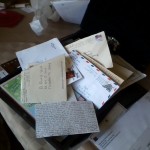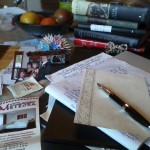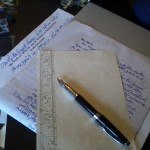My dear To Whom It May Concern,
I am writing this letter to you to explain why I write letters. Since the new year started, I have hand-written 50 or so letters, postcards, thank you notes and other cards. In spite of this, I receive no mail back. If I get a response…
(Wode Toad i s telling me to stop whining and feeling sorry for myself,
s telling me to stop whining and feeling sorry for myself,  and to get on with it. He is right, I have gotten letters from my daughter every week, two letters from Walter, one from Brandon, and an incredible origami artwork from Josie.)
and to get on with it. He is right, I have gotten letters from my daughter every week, two letters from Walter, one from Brandon, and an incredible origami artwork from Josie.)
As with most of my writings, I am both typing this and writing it out by hand, so I will send the handwritten copy to the first person I get a letter from after I post this.
In 1935, the philosopher Walter Benjamin wrote a famous essay entitled “The Work of Art in the Age of Mechanical Reproduction.” He explores how being reproduced changes the nature of a work of art. Of course, art has always been copyable, but the possibility of large scale mechanical reproduction and the development of forms of art such as photography and film which specifically rely upon this ability change how exactly we interact with art. Benjamin is writing as a child of the 19th century in the earlier 20th century, observing as large scale mechanical reproduction is becoming more and more common, but is not yet ubiquitous.
For Benjamin, there is something that is lost in the transition between an original work of art and a reproduction, and, in fact, with reproduced art there is not even a clear distinction of “original.” Although we can speak of “Master copies,” there is no real way in which the first copy of a film has any sort of privilege over copies. Benjamin calls that which is lacking in reproductions an “aura.” This aura included such things as a certain authority, an ability to stand back and consider this one artifact as the authoritative version of this work; in addition to this, a work of art is located within a specific time and place having been brought to that time and place through a specific history.
Furthermore, it is located–enmeshed–within a specific tradition. The mechanical reproduction, by contrast, floats independently and unattached. Although there is only one original work, it is open to perspective, allowing its few viewers to walk around it and see it from several sides, standing face to face with the work of art, reacting to it and–in the case of performed art–being reacted to. By contrast, mechanically reproduced art forces its mass viewers to assume a certain viewpoint–that of the camera operator or editor. While the observer is absorbed in the original work of art, the purpose of the mass produced reproduction is to distract.
One of the biggest changes in perception in the age of mechanical reproduction is that reproduction by sheer volume will eventually become the norm, and at one point we will not be able to even see a difference. What Benjamin didn’t foresee was the primacy of mass media, that at some point mechanical reproductions would not only have primacy over original, unique art, but that at some point reproduction would come to seem more real than the reality it represented and reproduced.
I am not entirely sure I agree with Benjamin, I love cinema and photography as art forms, and am unwilling to write them off. I definitely think he attributes a little too much to the mysterious aura of the art object–even using the language of religious mysticism and magic, but there is something different to created art as opposed to reproduced art. I have seen many of the great painting & sculptures that I also saw reproduced as little pictures in my textbooks, but also as posters and prints. The magic–and I really cannot think of another adequate word–of standing before Rembrandt’s The Night Watch in Amsterdam of Van Gogh’s Starry Night in New York or within an actual Cathedral is inexpressible. I am not sure what the aura of the authentic work is, but there definitely is something. Performed art can be made more perfect through multiple takes and editing, but there is something raw and beautiful that makes a live musical or theatrical performance so wonderful. I have a recording of Townes Van Zandt singing “If I Needed You.” I also saw him perform it live. The recording is actually better–his voice was pretty much shot by the time I saw him in 1990–but there was something about hearting Townes himself sing it, 100 or so feet away, under the July stars in Nashville. There is an aura, an authenticity, to an original work shared directly.
If I needed you would you come to me,
Would you come to me, and ease my pain?
If you needed me
I would come to you
I’d swim the seas for to ease your pain.
That is why I like to send hand written letters. Putting my words here onto the glowing screen sets them into an inorganic detached place, a place without history or  context. Even as watch myself type them, the words become as indifferent to me as an article on Wikipedia. As you read them, you are reading them at a remove from me. The paper of a letter does not remove my words from me the way the screen does. They remain mine (and, given the nature of my handwriting, clearly, uniquely, and irrefutably mine), and when you read my letter they are still my writing, my marks, my words, but in your hand: they are now ours. Like the bread I have brought to your house, we are now sharing.
context. Even as watch myself type them, the words become as indifferent to me as an article on Wikipedia. As you read them, you are reading them at a remove from me. The paper of a letter does not remove my words from me the way the screen does. They remain mine (and, given the nature of my handwriting, clearly, uniquely, and irrefutably mine), and when you read my letter they are still my writing, my marks, my words, but in your hand: they are now ours. Like the bread I have brought to your house, we are now sharing.
Where is the text I sent you?
To whom does it belong?
Where is the note you sent me on Facebook or in an email or by text? It might be in the cloud or on a mainframe somewhere, or on your phone, but are those real places?
Can you put a text in your shirt pocket next to your heart, or keep it under your pillow?
Although we strive to live authentic lives in this 21st Century world, we have given up the very things that allow us to be authentic: knowing the person who grew our food, or even the person from whom we buy it, having our food reproduced for us rather than shaping it and making it ourselves, and investing ourselves (in my case, often a little blood) in our food, sewing our own clothes or working on our own houses and yards. In our jobs we are simply tools of mechanical reproduction, and in our lived lives we are allowing ourselves to become works of mechanical reproduction.
Furthermore, most of us are losing the ability to even recognize the difference: we do not know what it would be like to grow our own food, and we do not even recognize what it looks like before it is our food–on the vine or on the hoof. We do not know how to talk to a vendor at a road side stand or a butcher. Many of us do not know–or have only a faint childhood memory or the reminiscences of our parents and grandparents–what we have lost by eating “prepared” food rather than slow food cooked from scratch. Many of us have never owned an article of clothing that is unique, which could not be worn by hundreds, even thousands of others who went shopping around the same time. Soon, we might no longer remember what it felt like to connect with a friend–or even a stranger–in genuine conversation, or, if we do, it will be a distant memory, something else we experimented with when we were in college but have left behind.
The last hope of authenticity is also the first foundation of being human: being in touch with our fellow human beings. And so, to be authentic, we must try to restore authentic modes of staying in touch: genuine face to face (or side by side) conversations, eye contact and common courtesy, playful interaction, and open, honest conversation.
Since we live in a world in which we are increasingly separated from  our friends and family, we must cultivate ways of staying in touch which have the same aura of authenticity. That, my dear to whom it may concern, is why I still write letters by hand. Yes, an email, a Facebook post, a tweet, even an abrev’d text can have the same touching quality as a letter or even a heart to heart face to face, but if we never write and seldom talk, it is more likely that all our interactions will become inane twitter, or even the interpreted signage of Pinterest, instead of becoming more like conversations. If, however, we continue to write, to take the time to form our own words and to send them, perhaps that aura of authenticity will inform even our humblest text.
our friends and family, we must cultivate ways of staying in touch which have the same aura of authenticity. That, my dear to whom it may concern, is why I still write letters by hand. Yes, an email, a Facebook post, a tweet, even an abrev’d text can have the same touching quality as a letter or even a heart to heart face to face, but if we never write and seldom talk, it is more likely that all our interactions will become inane twitter, or even the interpreted signage of Pinterest, instead of becoming more like conversations. If, however, we continue to write, to take the time to form our own words and to send them, perhaps that aura of authenticity will inform even our humblest text.

Just a note:
Yes, I will send a hand-written letter and the draft of this article to the sender to the first letter I get after the 28th of February when this posts.
…but I still love hearing from you, and will not hate you–in fact, I will still appreciate you–if you leave comments here in the Reply Section.
After receiving one of your handwritten notes earlier this year, I was inspired to write more notes. I’ve been writing 2 notes every Sunday morning to people at my church (and your church). I’m simply moving through the entire directory and only skipping people who I don’t know at all or who have moved. I have really enjoyed it and several people have been so excited about receiving mail. Thank you for the post.
I did mean everything I said in the letter, Mary, and I am so glad to hear that you are writing letters. It has been a really great way to stay in touch with our college Shields, as well.
I have considered sending hand-written letters to friends of mine that live right here in town, simply because I know they would appreciate it and would write back, and we’d actually communicate more that way. I don’t know why I haven’t started actually DOING it. Last summer I went through a bunch of college stuff and was amazed to discover not just reams of letters from the people I remembered being letter writers, but notes from the friends who didn’t seem at all like letter writers–because that was the only way we communicated with our friends when we were in college and much too poor to make long-distance phone calls when we were all scattered around the country at home for the summer. I think I tend to be more open and share more about myself in writing than I do in person. As as result, the waning of letter writing in my life means that I am less known than I used to be…and I miss being known in that way. Great post, Robert.
I actually have a handwritten copy of last week’s post I was going to send to you, Giedra; I’ve been meaning to figure out your address. Yes, besides just what a letter does, I also find it easier to be more open and honest writing a letter. Of course, as a counter argument to my thesis here, I’ve said things in the bistro I would never say in person, either.
I still send hand-written (and sometimes hand-pressed) birthday cards to a few friends, but I think it’s more for me than for them…you know, an excuse to use a pen and write.
I love that! That seems even more personal.
Hi Robert,
I loved your letter and have been composing my reply in my head ever since. I am about ready to commit it to paper, my hand stayed only by its self-awareness of how awful its penmanship is. Still, it shall scribble on.
So please advise Wode Toad that, as a friend’s young sister once said, “Patience is a virgin.” And a letter will be on its way to you soon.
Brandon
What’s up i am kavin, its my first time to commenting anyplace, when i read this piece of writing i thought i could also create comment due to this sensible piece of writing.
Sie sind denn aus Munchen? I han gehort das es da ein kaltes winter gab.